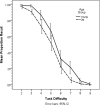Aging and effort expenditure: The impact of subjective perceptions of task demands
- PMID: 27831709
- PMCID: PMC5123849
- DOI: 10.1037/pag0000127
Aging and effort expenditure: The impact of subjective perceptions of task demands
Abstract
Engagement in cognitively demanding activities has a positive impact on cognitive health in older adults. Previous work, however, has suggested that the costs associated with engagement increase in later life and influence motivation. We examined how subjective perceptions of these costs varied with age and influenced task engagement. The following questions were of specific interest: (a) Are there age differences in subjective perceptions of cognitive costs? (b) What is the impact of these perceptions on engagement? We tested 39 older (ages 65-84) and 37 younger (20-42) adults on a working memory task. Systolic blood pressure responsivity (SBP-R; reflective of effort) and subjective perceptions of task difficulty were assessed. We found that age was associated with an increase in the perceptions of cognitive costs, and that these subjective perceptions had a stronger impact on older adults' engagement than on that of younger adults. More important, this impact was specific to subjective perceptions of cognitive costs. The results provide further support for the hypothesis that increased costs associated with cognitive engagement influence older adults' willingness to engage cognitive resources, and that these costs in part reflect subjective perceptions that are independent of objective task demands. (PsycINFO Database Record
(c) 2016 APA, all rights reserved).
Figures




Similar articles
-
The impact of age and motivation on cognitive effort: implications for cognitive engagement in older adulthood.Psychol Aging. 2013 Jun;28(2):495-504. doi: 10.1037/a0031255. Epub 2013 Feb 18. Psychol Aging. 2013. PMID: 23421325 Free PMC article. Clinical Trial.
-
Predictors of engagement in young and older adults: The role of specific activity experience.Psychol Aging. 2021 Mar;36(2):131-142. doi: 10.1037/pag0000561. Epub 2020 Jul 20. Psychol Aging. 2021. PMID: 32686945 Free PMC article.
-
Perceptions of task difficulty predict cognitive effort for older adults.Neuropsychol Dev Cogn B Aging Neuropsychol Cogn. 2025 Mar;32(2):193-206. doi: 10.1080/13825585.2024.2366033. Epub 2024 Jun 13. Neuropsychol Dev Cogn B Aging Neuropsychol Cogn. 2025. PMID: 38869322
-
The ironic effect of older adults' increased task motivation: Implications for neurocognitive aging.Psychon Bull Rev. 2021 Dec;28(6):1743-1754. doi: 10.3758/s13423-021-01963-4. Epub 2021 Jun 25. Psychon Bull Rev. 2021. PMID: 34173190 Review.
-
What Is Mental Effort: A Clinical Perspective.Biol Psychiatry. 2024 Jun 1;95(11):1030-1037. doi: 10.1016/j.biopsych.2024.01.022. Epub 2024 Feb 1. Biol Psychiatry. 2024. PMID: 38309319 Review.
Cited by
-
Purpose in Life and Cognition Interact to Impact Healthcare and Financial Decision Making in Old Age.J Appl Gerontol. 2022 Aug;41(8):1887-1895. doi: 10.1177/07334648221095514. Epub 2022 May 11. J Appl Gerontol. 2022. PMID: 35543174 Free PMC article.
-
The role of cognitive costs, attitudes about aging, and intrinsic motivation in predicting engagement in everyday activities.Psychol Aging. 2018 Sep;33(6):953-964. doi: 10.1037/pag0000289. Psychol Aging. 2018. PMID: 30198733 Free PMC article.
-
Motor Planning of Vertical Arm Movements in Healthy Older Adults: Does Effort Minimization Persist With Aging?Front Aging Neurosci. 2020 Feb 25;12:37. doi: 10.3389/fnagi.2020.00037. eCollection 2020. Front Aging Neurosci. 2020. PMID: 32161533 Free PMC article.
-
Development and Co-design of NeuroOrb: A Novel "Serious Gaming" System Targeting Cognitive Impairment in Parkinson's Disease.Front Aging Neurosci. 2022 Mar 29;14:728212. doi: 10.3389/fnagi.2022.728212. eCollection 2022. Front Aging Neurosci. 2022. PMID: 35422697 Free PMC article.
-
How older adults manage misinformation and information overload - A qualitative study.BMC Public Health. 2024 Mar 21;24(1):871. doi: 10.1186/s12889-024-18335-x. BMC Public Health. 2024. PMID: 38515081 Free PMC article.
References
-
- Brehm JW, Self EA. The intensity of motivation. Annual Review of Psychology. 1989;40:109–131. doi:10.1146/annurev.ps.40.020189.000545. - PubMed
-
- Carlson MC, Saczynski JS, Rebok GW, Seeman T, Glass TA, McGill S, et al. Exploring the effects of an everyday activity program on executive function and memory in older adults: Experience Corps. The Gerontologist. 2008;48:793–801. doi: 10.1093/geront/48.6.793. - PubMed
-
- Gendolla GHE, Wright RA, Richter M. Effort intensity: Some insights from the cardiovascular system. In: Ryan RM, editor. The Oxford handbook of human motivation. Oxford University Press; New York, NY: 2012. pp. 420–438.
MeSH terms
Grants and funding
LinkOut - more resources
Full Text Sources
Other Literature Sources
Medical

